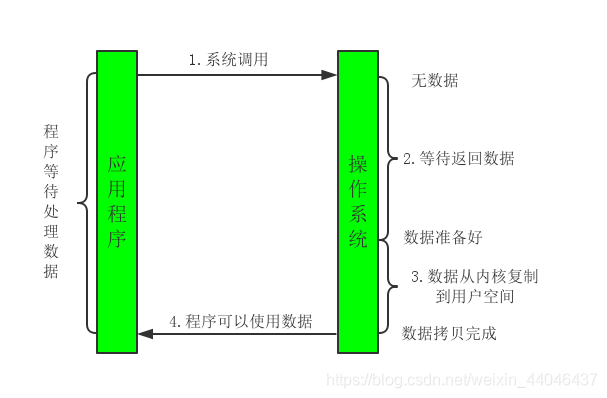同步、异步,阻塞、非阻塞概念
- io操作分为两部分,发起io请求,和io数据读写。阻塞、非阻塞主要是针对线程发起io请求后,是否立即返回来定义的,立即返回称为非阻塞io,否则称为阻塞io。
- 同步、异步主要针对io数据读写来定义的,读写数据过程中不阻塞线程称为异步io,否则,称为同步io。
BIO:同步阻塞IO
BIO:线程发起io请求后,一直阻塞(阻塞io),直到数据就绪后,用户线程将数据写入socket空间,或从socket空间读取数据(同步)。

使用BIO实现文件的读取和写入
//Initializes The Object
User1 user = new User1();
user.setName("hollis");
user.setAge(23);
System.out.println(user);
//Write Obj to File
ObjectOutputStream oos = null;
try {
oos = new ObjectOutputStream(new FileOutputStream("tempFile"));
oos.writeObject(user);
} catch (IOException e) {
e.printStackTrace();
} finally {
IOUtils.closeQuietly(oos);
}
//Read Obj from File
File file = new File("tempFile");
ObjectInputStream ois = null;
try {
ois = new ObjectInputStream(new FileInputStream(file));
User1 newUser = (User1) ois.readObject();
System.out.println(newUser);
} catch (IOException e) {
e.printStackTrace();
} catch (ClassNotFoundException e) {
e.printStackTrace();
} finally {
IOUtils.closeQuietly(ois);
try {
FileUtils.forceDelete(file);
} catch (IOException e) {
e.printStackTrace();
}
}
//Initializes The Object
User1 user = new User1();
user.setName("hollis");
user.setAge(23);
System.out.println(user);
//Write Obj to File
ObjectOutputStream oos = null;
try {
oos = new ObjectOutputStream(new FileOutputStream("tempFile"));
oos.writeObject(user);
} catch (IOException e) {
e.printStackTrace();
} finally {
IOUtils.closeQuietly(oos);
}
//Read Obj from File
File file = new File("tempFile");
ObjectInputStream ois = null;
try {
ois = new ObjectInputStream(new FileInputStream(file));
User1 newUser = (User1) ois.readObject();
System.out.println(newUser);
} catch (IOException e) {
e.printStackTrace();
} catch (ClassNotFoundException e) {
e.printStackTrace();
} finally {
IOUtils.closeQuietly(ois);
try {
FileUtils.forceDelete(file);
} catch (IOException e) {
e.printStackTrace();
}
}
NIO:同步非阻塞IO
NIO:线程发起io请求后,立即返回(非阻塞io)。用户线程不阻塞等待,但是,用户线程要定时轮询检查数据是否就绪,当数据就绪后,用户线程将数据从用户空间写入socket空间,或从socket空间读取数据到用户空间(同步)。

NIO实现原理(重点)
IO多路复用(NIO):上述NIO实现中,需要用户线程定时轮训,去检查IO数据是否就绪,占用应用程序线程资源。IO多路复用模型中,将检查IO数据是否就绪的任务,交给系统级select(window)或poll(Linux)模型,由系统进行监控,减轻用户线程负担。
当用户线程发起io请求后,将socket连接及关注事件注册到selector(多路复用器,os级别线程)上,selector循环遍历socket连接,看是否有关注数据就绪,如果连接有数据就绪后,就通知应用程序,建立线程进行数据读写。同BIO对比,NIO中线程处理的都是有效连接(数据就绪),且一个线程可以分管处理多个连接上的就绪数据,节省线程资源开销。
1)select:注册的socket事件由数组管理,长度有限制,轮询查找时需要遍历数组。
2)poll:注册的socket事件由链表实现,数量没有限制,遍历链表轮询查找。
使用NIO实现文件的读取和写入
static void readNIO() {
String pathname = "C:\\Users\\adew\\Desktop\\jd-gui.cfg";
FileInputStream fin = null;
try {
fin = new FileInputStream(new File(pathname));
FileChannel channel = fin.getChannel();
int capacity = 100;// 字节
ByteBuffer bf = ByteBuffer.allocate(capacity);
int length = -1;
while ((length = channel.read(bf)) != -1) {
bf.clear();
byte[] bytes = bf.array();
System.out.write(bytes, 0, length);
System.out.println();
}
channel.close();
} catch (FileNotFoundException e) {
e.printStackTrace();
} catch (IOException e) {
e.printStackTrace();
} finally {
if (fin != null) {
try {
fin.close();
} catch (IOException e) {
e.printStackTrace();
}
}
}
}
static void writeNIO() {
String filename = "out.txt";
FileOutputStream fos = null;
try {
fos = new FileOutputStream(new File(filename));
FileChannel channel = fos.getChannel();
ByteBuffer src = Charset.forName("utf8").encode("你好你好你好你好你好");
int length = 0;
while ((length = channel.write(src)) != 0) {
System.out.println("写入长度:" + length);
}
} catch (FileNotFoundException e) {
e.printStackTrace();
} catch (IOException e) {
e.printStackTrace();
} finally {
if (fos != null) {
try {
fos.close();
} catch (IOException e) {
e.printStackTrace();
}
}
}
}
AIO(NIO 2.0升级版):异步非阻塞IO
AIO:线程发起io请求后,立即返回(非阻塞io),当数据读写完成后,OS通知用户线程(异步)。这里数据写入socket空间,或从socket空间读取数据到用户空间由OS完成,用户线程无需介入,所以也就不会阻塞用户线程,即异步。

AIO基于时间驱动思想,采用proactor模式。数据完成后,由os主动通知应用程序,通过epoll实现,节省了NIO中selector循环遍历检测数据就绪的资源开销。同时,数据copy操作(用户空间<->socket空间)是由os完成的,无需应用程序参与,大大提高应用程序效率。
注:epoll(Liunx系统的一个函数,Window上没有,window上有个类似的IOCP):基于事件驱动思想,采用reactor模式,通过事件回调,无需使用某种方式主动检查socket状态,被动接收就绪事件即可。
使用AIO实现文件的读取和写入
public class ReadFromFile {
public static void main(String[] args) throws Exception {
Path file = Paths.get("/usr/a.txt");
AsynchronousFileChannel channel = AsynchronousFileChannel.open(file);
ByteBuffer buffer = ByteBuffer.allocate(100_000);
Future<Integer> result = channel.read(buffer, 0);
while (!result.isDone()) {
ProfitCalculator.calculateTax();
}
Integer bytesRead = result.get();
System.out.println("Bytes read [" + bytesRead + "]");
}
}
class ProfitCalculator {
public ProfitCalculator() {
}
public static void calculateTax() {
}
}
public class WriteToFile {
public static void main(String[] args) throws Exception {
AsynchronousFileChannel fileChannel = AsynchronousFileChannel.open(
Paths.get("/asynchronous.txt"), StandardOpenOption.READ,
StandardOpenOption.WRITE, StandardOpenOption.CREATE);
CompletionHandler<Integer, Object> handler = new CompletionHandler<Integer, Object>() {
@Override
public void completed(Integer result, Object attachment) {
System.out.println("Attachment: " + attachment + " " + result
+ " bytes written");
System.out.println("CompletionHandler Thread ID: "
+ Thread.currentThread().getId());
}
@Override
public void failed(Throwable e, Object attachment) {
System.err.println("Attachment: " + attachment + " failed with:");
e.printStackTrace();
}
};
System.out.println("Main Thread ID: " + Thread.currentThread().getId());
fileChannel.write(ByteBuffer.wrap("Sample".getBytes()), 0, "First Write",
handler);
fileChannel.write(ByteBuffer.wrap("Box".getBytes()), 0, "Second Write",
handler);
}
}
白话文解释三者区别
烧水事件:
BIO(同步阻塞模式):这种模式下,我们的工作模式是先来到厨房,开始烧水,并坐在水壶面前一直等着水烧开。
NIO(同步非阻塞模式):这种模式下,我们的工作模式是先来到厨房,开始烧水,但是我们不一直坐在水壶前面等,而是回到客厅看电视,然后每隔几分钟到厨房看一下水有没有烧开。
AIO(异步非阻塞I/O模型):这种模式下,我们的工作模式是先来到厨房,开始烧水,我们不一一直坐在水壶前面等,也不隔一段时间去看一下,而是在客厅看电视,水壶上面有个开关,水烧开之后他会通知我。
阻塞VS非阻塞:人是否坐在水壶前面一直等。
同步VS异步:水壶是不是在水烧开之后主动通知人。
BIO、NIO、AIO适用场景分析:
- BIO方式适用于连接数目比较小且固定的架构,这种方式对服务器资源要求比较高,并发局限于应用中,JDK1.4以前的唯一选择,但程序直观简单易理解。
- NIO方式适用于连接数目多且连接比较短(轻操作)的架构,比如聊天服务器,并发局限于应用中,编程比较复杂,JDK1.4开始支持。
- AIO方式使用于连接数目多且连接比较长(重操作)的架构,比如相册服务器,充分调用OS参与并发操作,编程比较复杂,JDK7开始支持。
